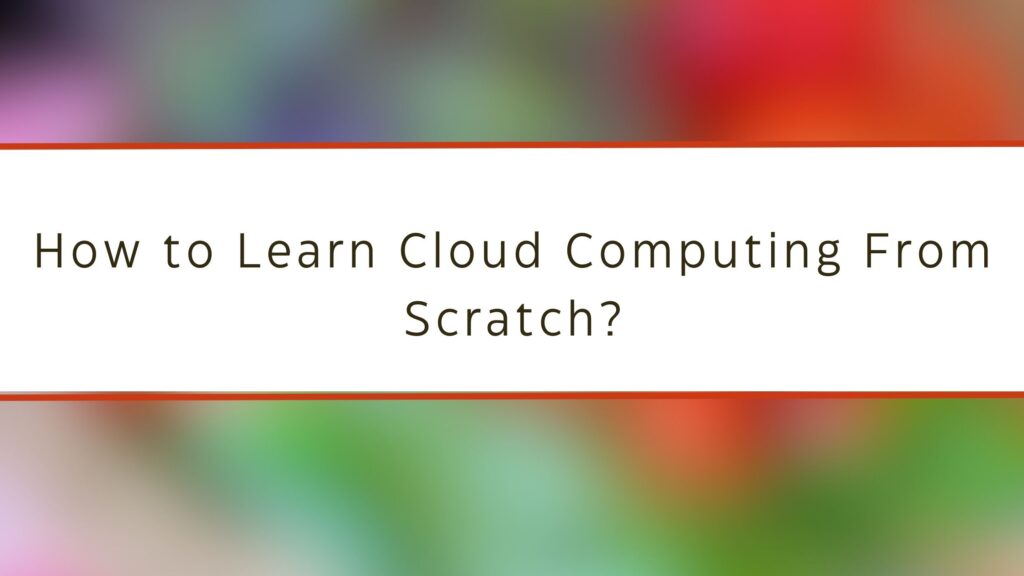Do you want to know How to Learn Cloud Computing From Scratch?… If yes, you are in the right place. In this blog, I will share a step-by-step roadmap to learn Cloud Computing. Along with that, I will also share some of the best resources for learning Cloud Computing.
So, let’s get started and see How to Learn Cloud Computing From Scratch–
How to Learn Cloud Computing From Scratch?
How to Learn Cloud Computing From Scratch?
Understanding Cloud Computing
Before we jump into learning, let’s get a clear understanding of what cloud computing is. Think of it as a virtual space where you can store, manage, and access data and applications over the internet, instead of relying on physical hardware like your computer’s hard drive. Here are some key concepts to grasp:
Step 1: Explore Cloud Computing Concepts
- On-Demand Service: Understand how cloud services provide resources whenever you need them without the need for physical infrastructure.
- Scalability: Learn about how cloud services can scale up or down based on demand, offering flexibility and cost-effectiveness.
- Pay-as-You-Go: Grasp the concept of paying only for the resources you use, making it economically viable for businesses of all sizes.
Step 2: Familiarize Yourself with Cloud Service Models
- IaaS (Infrastructure as a Service): Understand how IaaS provides virtualized computing resources over the Internet.
- PaaS (Platform as a Service): Learn about PaaS offerings, which provide a platform allowing customers to develop, run, and manage applications without dealing with infrastructure.
- SaaS (Software as a Service): Explore SaaS applications, which are hosted in the cloud and accessible via the internet.
Setting Learning Goals
Now that you understand the basics, it’s time to set your learning goals. What do you want to achieve by learning cloud computing? Here are a few common objectives to consider:
Step 1: Define Your Objectives
- Understanding Cloud Architecture: Determine if you want to learn about different cloud service models and deployment models.
- Mastering Cloud Platforms: Decide if you want to focus on specific cloud platforms like AWS, Azure, or GCP.
- Acquiring Practical Skills: Consider if you want hands-on experience working on real-world projects.
- Earning Certifications: Evaluate if pursuing certifications aligns with your career goals.
Step 2: Break Down Your Goals into Achievable Milestones
- Short-Term Goals: Set goals that you can achieve within a few weeks or months, such as completing an online course or building a basic cloud application.
- Medium-Term Goals: Aim for milestones that require more time and effort, such as earning a certification or contributing to a cloud-related project.
- Long-Term Goals: Identify where you want to be in your cloud computing journey in the next few years and plan accordingly.
Building a Strong Foundation
Like constructing a building, you need a solid foundation to excel in cloud computing. Here’s how to build yours:
Step 1: Learn the Basics of Networking
Understanding networking fundamentals is crucial for cloud computing. Start by grasping concepts like IP addresses, subnets, DNS, and routing. Online resources, tutorials, and courses can help you get started.
Step 2: Explore Operating Systems
Familiarize yourself with operating systems like Linux and Windows. Linux, in particular, is widely used in cloud environments due to its stability, security, and flexibility.
Step 3: Dive into Virtualization
Virtualization lies at the heart of cloud computing. Learn about hypervisors, virtual machines (VMs), containers, and container orchestration tools like Docker and Kubernetes.
Choosing the Right Learning Resources
With so many resources available, it’s essential to choose the ones that best suit your learning style. Here are some options to consider:
Step 1: Research Learning Platforms
- Online Courses: Explore platforms like Coursera, Udacity, and Udemy for cloud computing courses tailored to beginners.
- Documentation and Tutorials: Dive into the documentation provided by cloud service providers for comprehensive guides and tutorials.
- Community Forums and Discussion Groups: Join online forums like Stack Overflow, Reddit, or official cloud platform forums to engage with the community.
Step 2: Evaluate Hands-On Opportunities
- Free Tier Accounts: Sign up for free tier accounts on cloud platforms like AWS, Azure, and GCP to practice your skills without incurring costs.
- Project-Based Learning: Look for project-based courses or tutorials that allow you to apply theoretical knowledge to real-world scenarios.
- Open-Source Contributions: Consider contributing to open-source projects related to cloud computing to gain practical experience and collaborate with others.
Practical Hands-On Experience
Theory is essential, but practical experience is where the real learning happens. Here’s how to get hands-on with cloud computing:
Step 1: Create a Sandbox Environment
Set up a sandbox environment on your computer or use a cloud platform’s free tier to experiment without worrying about cost. Practice launching virtual machines, deploying applications, and configuring networking.
Step 2: Work on Projects
Start with simple projects like hosting a website or setting up a database server. As you gain confidence, challenge yourself with more complex projects that simulate real-world scenarios.
Step 3: Collaborate with Others
Join online communities or find study groups where you can collaborate on projects. Working with others not only enhances your learning but also exposes you to different perspectives and approaches.
Stay Updated and Keep Learning
Cloud computing is a rapidly evolving field, so staying updated is crucial. Here’s how to keep your skills sharp:
Step 1: Follow Industry News
Subscribe to blogs, newsletters, and podcasts that cover cloud computing trends and updates. Stay informed about new technologies, services, and best practices.
Step 2: Attend Webinars and Workshops
Participate in webinars and workshops hosted by cloud service providers or industry experts. Take advantage of opportunities to learn from professionals and expand your network.
Step 3: Continuously Expand Your Skill Set
Don’t limit yourself to just one cloud platform or technology. Explore new tools, services, and concepts to broaden your knowledge and stay competitive in the job market.
Resources to Learn Cloud Computing
- Become a Cloud Developer– Udacity
- Become a Cloud DevOps Engineer– Udacity
- Introduction to Cloud Computing– Coursera
- Cloud Computing Fundamentals on Alibaba Cloud– Coursera
- Intro to Cloud Computing– Udacity FREE Course
- Cloud-Native Fundamentals– Udacity FREE Course
- Google Cloud Digital Leader Training– Udacity FREE Course
- Hybrid Cloud Fundamentals– Udacity FREE Course
- AWS Cloud Practitioner Essentials– Coursera
- Cloud Computing Basics– Coursera
- Cloud Computing Foundations– Coursera
- Introduction to Cloud Computing on AWS for Beginners– Udemy
- Cloud Computing for Beginners-Udemy
- Cloud DevOps using Microsoft Azure– Udacity
- Become an AWS Cloud Architect– Udacity
- Cloud Computing for Business Leaders– Udacity
How Much Time Does It Take to Learn Cloud Computing?
| Time Span | Activities |
|---|---|
| Week 1-2 | – Understand basic cloud concepts: Start by learning what the cloud is and how it works. Watch introductory videos or read beginner-friendly articles. |
| – Explore different cloud service models: Learn about Infrastructure as a Service (IaaS), Platform as a Service (PaaS), and Software as a Service (SaaS). Understand their differences and use cases. | |
| – Decide on learning goals and objectives: Reflect on why you want to learn cloud computing and what you hope to achieve. Write down your goals to stay focused. | |
| Week 3-4 | – Learn networking fundamentals: Dive into basic networking concepts such as IP addresses, subnets, and DNS. There are many online tutorials and courses available for free. |
| – Familiarize yourself with operating systems: Experiment with Linux and Windows environments. Set up virtual machines on your computer to practice. | |
| – Dive into virtualization basics: Understand what virtualization is and how it’s used in cloud computing. Explore tools like VirtualBox or VMware for hands-on experience. | |
| Week 5-6 | – Research and choose learning resources: Explore different online platforms such as Coursera, Udemy, or free resources provided by cloud service providers. Read reviews and testimonials to find the best fit for your learning style. |
| – Start beginner courses or tutorials: Enroll in beginner-level courses or follow step-by-step tutorials to get hands-on experience. Focus on building a strong foundation. | |
| – Practice setting up a simple cloud environment: Sign up for a free tier account on a cloud platform like AWS, Azure, or GCP. Follow guided tutorials to set up your first virtual machine or storage bucket. | |
| Week 7-8 | – Continue with intermediate-level courses: Progress to more advanced topics such as cloud architecture, security, and automation. Challenge yourself with hands-on labs and projects. |
| – Work on hands-on projects: Apply your knowledge by working on practical projects. Build a simple web application, set up a database server, or automate routine tasks using cloud services. | |
| – Join online communities for support and advice: Engage with fellow learners and professionals in forums, social media groups, or online communities. Ask questions, share your experiences, and learn from others. | |
| Week 9-10 | – Complete advanced courses or certification prep: Prepare for certifications like AWS Certified Solutions Architect or Microsoft Certified: Azure Administrator. Review exam guides and practice with sample questions. |
| – Engage in collaborative projects: Collaborate with others on group projects or open-source contributions. Work on real-world scenarios to deepen your understanding and gain practical experience. | |
| – Stay updated with industry news and trends: Follow blogs, podcasts, or social media accounts related to cloud computing. Attend webinars or virtual events to learn about the latest developments and best practices. | |
| Ongoing | – Continuously practice and experiment in the cloud: Keep honing your skills by exploring new services, experimenting with different configurations, and troubleshooting issues. |
| – Stay curious and keep learning new skills: The cloud computing landscape is constantly evolving. Stay curious, embrace challenges, and never stop learning. |
Conclusion
In this article, I have discussed a step-by-step roadmap on How to Learn Cloud Computing From Scratch. If you have any doubts or queries, feel free to ask me in the comment section. I am here to help you.
All the Best for your Career!
Happy Learning!
FAQ
You May Also Be Interested In
10 Best Online Courses for Data Science with R Programming
8 Best Free Online Data Analytics Courses You Must Know in 2025
Data Analyst Online Certification to Become a Successful Data Analyst
8 Best Books on Data Science with Python You Must Read in 2025
14 Best+Free Data Science with Python Courses Online- [Bestseller 2025]
10 Best Online Courses for Data Science with R Programming in 2025
8 Best Data Engineering Courses Online- Complete List of Resources
Thank YOU!
To explore More about Data Science, Visit Here
Though of the Day…
‘ It’s what you learn after you know it all that counts.’
– John Wooden
Written By Aqsa Zafar
Founder of MLTUT, Machine Learning Ph.D. scholar at Dayananda Sagar University. Research on social media depression detection. Create tutorials on ML and data science for diverse applications. Passionate about sharing knowledge through website and social media.

